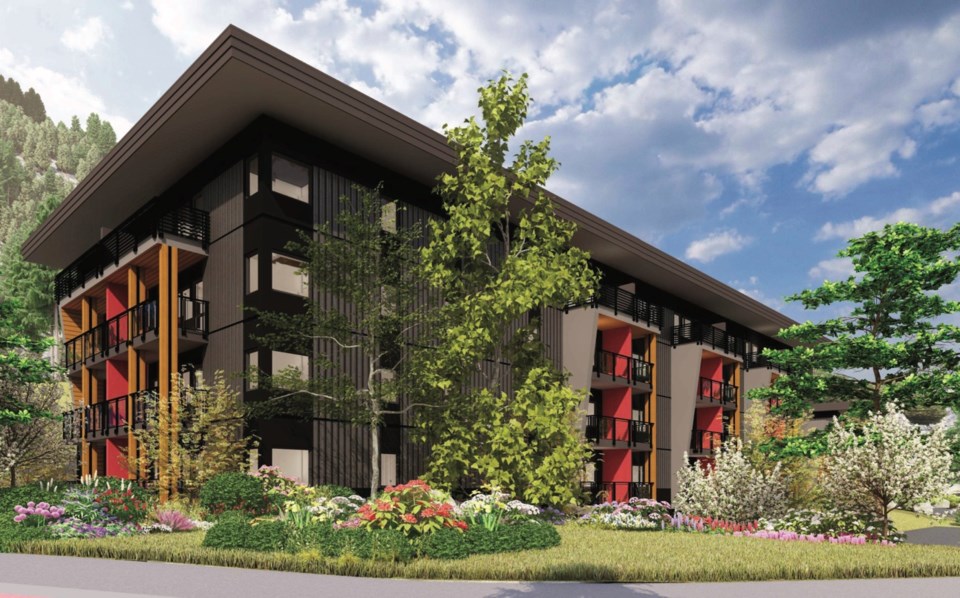Whistler's mayor and council has approved stumping up $3.2 million to go towards the construction of employee housing at 1475 Mount Fee Road, hot on the heels of the province pouring $12.7 million into the same project.
Councillors approved moving $3.2 million from the employee housing reserve fund to the Whistler Housing Authority (WHA), to make up the Resort Municipality of Whistler’s (RMOW) portion of what will be a $45.2-million project to deliver 104 units in two buildings on one lot in Whistler's Cheakamus neighbourhood.
The project, currently under construction, has an expected move-in date for residents in early 2026.
According to the RMOW's manager of projects planning, John Chapman, the $45.2-million project has a mortgageable value of $27.3 million, with an equity requirement of $17.9 million of which the majority—$12.7 million—will be covered by the provincial government. That funding was announced to much fanfare by B.C. Premier David Eby, who visited Whistler on July 22 to announce the cash infusion, while also availing the project to a further $27 million in low-interest financing.
Speaking just a day later at a regular council meeting, Chapman explained the $3.2 million from the RMOW employee housing reserve was about “meeting the equity gap” to ensure the building could proceed, with a further $2 million coming from the WHA to reach the $17.9 million. Further, $100,000 of the $3.2 million from the reserve came from Tourism Whistler contributions.
Notably, Chapman highlighted that much of the $3.2 million in reserve funds came from MRDT—or the hotel tax on overnight stays in the community.
“I want to note that affordable housing has recently become a permissible use of the MRDT, and if council approves this allocation it would be our first example of using MRDT in this way,” he said.
Chapman said the funding allocation was necessary to ensure units at 1475 Mount Fee Road would be made available to the community at affordable rates. As a building owned and operated by the WHA, it would be bound by municipal policy on affordable housing, linking the rent paid to 30 per cent of a tenant's net income.
That limitation through policynecessitated an extra infusion of funding, said Chapman.
“That’s a big part of the story: the cost of construction is higher than the mortgage that the net rental income would support," he said. "And so this equity contribution is required to bring the affordability in line with what we’re trying to offer to the community.”
Questions to staff on the funding ask, predictably, coalesced around numbers.
Councillor Cathy Jewett wanted to know the value of the land—”approximately $1.927 million” according to CAO Ginny Cullen—while Coun. Jeff Murl sought more detail on whether the $3.2 million was required in order to access the provincial funding source, to which he was told yes.
Murl also drilled down on detail—or lack thereof—on where the $27.3 million of mortgageable value number came from, and was told it was derived from—among other things—applied policy on rental income. Murl expressed a desire for more detail on the numbers on future projects, but ultimately supported the financial ask.
Coun. Ralph Forsyth asked for numbers on the income gap created by offering units at a rate geared to rental income versus market rate, explaining he wanted to "understand what the knock-on effects of the policy (of income-geared rental rates) are.”
Staff explained projects built in Cheakamus for employee housing were required to be built below market, and coupled with affordability metrics, and coming up with that number would be an exercise rather than an item to make a decision on, to which Forsyth repeated that he still sought more detail as a matter of course.
Mayor Jack Crompton jumped in to say he approved of the conversation, but added he believed it was better suited for committee-level discussions on policy or at a Committee of the Whole on how the RMOW’s policy binding WHA properties to particular rental rates impacted projects as they came through the construction pipeline.
“I think those are fascinating questions to ask, and I’d be really interested in the answers to them, but I think we should really focus on what we’re seeing in front of us today,” he said.
Forsyth said he agreed, but “it’s just a number I would like to know,” given community interest.
Jewett offered the observation that the overall cost of the project at $45.2 million was “probably one of the biggest” projects in Cheakamus, noting it was “about half the value of what it cost us to build the initial Athletes' Village ... and I think it’s more our concern as a council of ensuring we’re doing the right thing.”
Ultimately, council unanimously approved the funding request, and gave a formal thumbs up to shifting $3.2 million to the WHA for the project, and the update to the 2024 budget to reflect that change.
Crompton heaped praise on those involved in the process, and expressed excitement for future projects. Speaking before the decision came up at the meeting in delivering his Mayor’s Update, he labelled the $12.7 million “the single biggest investment in Whistler housing since the Olympics,” and touted the fact the RMOW was host to the first construction start of the provincial government’s $3-billion ‘BC Builds’ program, which is intended to speed up housing on properties owned by local governments, communities, and non-profit organizations through funding infusions.
“The BC Builds program has helped us go from concept to construction faster, so that we can continue to deliver more homes that people in our community can afford,” said Crompton.




